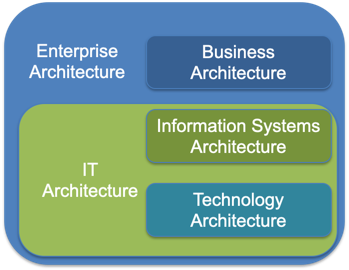Enterprise Architecture, Introduction to TOGAF
Enterprise Architecture
This post is an introduction to Enterprise Architecture. More specifically it covers what's Enterprise Architecture according to TOGAF.
Definition of Enterprise Architecture
Before we can define Enterprise Architecture, we need to define what's an "Enterprise" and what's an "Architecture".
TOGAF defines an "Enterprise" as:
The highest level (typically) of description of an organization and typically covers all missions and functions.
An enterprise will often span multiple organizations.
TOGAF defines "Architecture" as:
A formal description of a system, or a detailed plan of the system at component level, to guide its implementation (ISO/IEC 47010:2007). The structure of components, their inter-relationships, and the principles and guidelines governing their design and evolution over time.
What’s Enterprise Architecture ?
-
At its most effective, Enterprise Architecture enables effective execution of an organization’s strategy to achieve change
-
Business Architecture is a major enabling component of an Enterprise Architecture
-
IT Architecture is a major enabling component of an Enterprise Architecture
Domains of Architecture
Enterprise Architecture is composed of business architecture and IT architecture.

The Role of Enterprise Architecture
Enterprise Architecture is the description of an enterprise as a system in terms of its:
- Components
- Their inter-relationships
- Principles and Guidelines governing the design and its evolution
It's usually done to identify gaps between
- Current state
- Desired future state
Enterprise Architecture provides road-map for organization to:
- Achieve its goals
- Deliver its objectives
Often described at multiple levels of
- Breadth
- Depth
Benefits Of A Good Enterprise Architecture
Effective management and exploitation of information is key to business success and competitive advantage.
A good Enterprise Architecture:
- Optimizes the (fragmented) legacy of processes (manual and automated) to an integrated environment
- Responds to change
- Supports delivery of the business strategy
- Enables the right balance between IT efficiency and business innovation
Benefits are:
- A more efficient business operation
- Better return on existing investment, reduced risk for future investment
- A more efficient IT operation
- Faster, simpler and cheaper IT procurement
What prompts Enterprise Architecture development?
Preparation for business transformation or radical infrastructure changes initiates an enterprise architecture review or development.
Key people identify areas of change required for new business goals to be met.
These “stakeholders” have areas of interest -known as concerns- that need to be addressed.
The architect:
- Identifies and refines stakeholders’ requirements.
- Develops views of the architecture that address those concerns.
- Shows trade-offs that are necessary between conflicting concerns.
Without the Enterprise Architecture it is unlikely that all the concerns and requirements will be considered and met.
What's TOGAF
TOGAF stands for "The Open Group Architecture Framework".
The TOGAF standard is a framework for Enterprise Architecture. It may be used freely by any organization wishing to develop an Enterprise Architecture for use within that organization.

Version 9.2 was released in 2018.
TOGAF standard is available in the open group website TOGAF 9.2
That's all folks! Gonzalo Sáenz